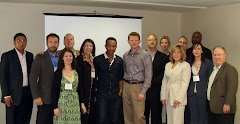Kim talked about how to lead high performing marketing teams in a tough economy -- how to navigate tightening budgets, outsourcing, and the fact that everyone is being asked to do more with less.
She recommends 4 steps anyone should take to adapt their teams:
- Assess team development and cohesion
- Provide clear strategy and objectives
- Commit to talent management
- And inspire them!
When organizations are in a financial pinch, there’s a challenge to balance enthusiasm about breakthrough ideas with the reality of how difficult it will be to commit resources to them. This can discourage teams, especially junior members who have not weathered recession before, but it’s imperative to explain why an idea that generates a lot of excitement one day might stay on the drawing board for a while. If not, you risk sending a mixed message.
As Kim built out the Walgreens marketing department, she realized there needed to be more synergy between agencies. Each agency worked with a different arm of the marketing team and were not engaging with one another, so Kim called a summit to bring the agencies together, get them to start a dialogue and work towards cohesion. Not only did her employees open the lines of communication, but the agencies began getting in touch to strategize, as well.
Four out of the five organization transformations Kim was a part of did not use an in-depth performance review system, which she found to be a major hindrance to uncovering problems among the talent base. In the transformation that did use a thoughtful performance review system, employees revealed some integral structural issues that needed to be fixed, allowing management to recalibrate with specific goals in mind.
With any reorganization, there are waves of energy and fatigue. Upon the launch of a new initiative, you’ll have many people on board, albeit cautiously. But after that first round of changes begins to take place, you’ll likely run into a lack of energy to continue down the course. It’s at this point when it’s most important to energize teams by showing them that the overarching goals are clear and still in the horizon. Otherwise you can lose them in what Kim calls “The Valley of Despair” – a low point in morale brought about by a lack of faith that the reorganization will ever be complete or achieve the original vision.
And take the time to let change become the norm. “People aren’t like computers,” Kim says, “You can’t just reprogram them and expect them to run smoothly right away. They need time to adjust.”
It might sound mushy at first to say “let’s make sure we care about the talent,” but too often it doesn’t get done. Bringing the right talent to an organization (and keeping them there) begins with knowing what talent you need in the first place, and what you don’t. “Don’t be afraid to fire ineffective leaders. Just do it,” Kim says. Even if someone can deliver results “their own way,” if they refuse to commit to new company values, visions and initiatives, it will trickle down and begin to affect junior members of their team and create animosity among other teams who are doing what is asked of them.
We’re in the age of what Kim calls “Inclusion Management,” where we should be asking members of our teams whether we are creating an environment that makes people feel included. Enlist an employee from the LGBT community or a minority group to become a coach who helps identify ways the rest of the organization can continue to make all employees feel like equals.
When you’re looking to inspire people, don’t be afraid to bring everyone to the table, regardless of title. If you create a War Room scenario, you can empower people to lend their own expertise when they feel like they have something valuable to contribute. “Let your people go sometimes,” Kim says. Set the goals and let them take some risks as they work out how to deliver. If you can show courage, it will catch on.
Tuesday, May 19, 2009
Subscribe to:
Post Comments (Atom)







No comments:
Post a Comment